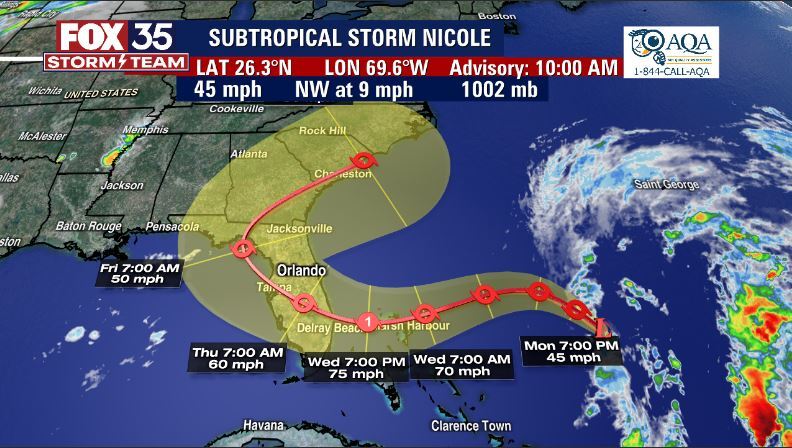Tracking Nicole: What's the difference between a tropical storm and a subtropical storm?

Nicole to become hurricane on approach to Florida
Subtropical Storm Nicole is forecast to become a Category 1 hurricane on its approach to the Florida coast on Wednesday. Portions of Central Florida are under hurricane and tropical storm watches.
With the formation of Subtropical Storm Nicole in the Atlantic Monday morning and its potential impacts on Florida this week, many are wondering what the differences are between a subtropical storm and a tropical storm.
FOX 35 Storm Team Chief Meteorologist Jayme King said there isn't much of a difference as impacts are still the same.
As a tropical storm moves into cooler water, it will begin to transition to a cold-core system. It's during this transition that a tropical storm can become subtropical.
A subtropical storm has characteristics of both tropical and extratropical cyclones. Most of its energy is derived from the clash of warm and cold air, but the cyclone does not have fronts and is cold-core in the upper levels of the atmosphere.
RELATED HEADLINES:
- Subtropical Storm Nicole forms in Atlantic with Florida in cone of uncertainty
- Timeline: When Subtropical Storm Nicole in Atlantic could impact Florida this week
- Sandbags: Where to get sandbags in Central Florida
- Orlando Hurricane Center: Latest tropical forecasts, spaghetti models, maps, and NHC forecast cone
- Continuing coverage: Latest stories and forecasts on Subtropical Storm Nicole
- FOX 35 Storm Team Center: Daily weather forecast, hour-by-hour forecast
Like tropical systems, a subtropical storm has a well-defined center and a closed circulation. However, the area of maximum winds within the circulation is farther away from the center and there is less symmetry, according to the NWS.
These storms generally produce less rain than a typical tropical system.
A subtropical cyclone can get stronger, but it must transition to a warm-core cyclone before it can be called a tropical storm or a hurricane.
Central Florida is bracing for severe weather as the Florida peninsula is in Nicole's cone of uncertainty.
Local impacts include strong winds, heavy rain, beach erosion, a Coastal Flood Watch, and the potential for power outages.
Beginning on Tuesday, The FOX 35 Storm Team said our area will begin to see increasing winds and late showers. The strongest winds will arrive on Wednesday through Thursday and beach conditions will worsen. On Friday, the system will begin to exit our area, though heavy rain and winds will continue.
The FOX 35 Storm Team will continue to monitor Nicole and will share any new developments and impacts for the Central Florida area as soon as details are available.

